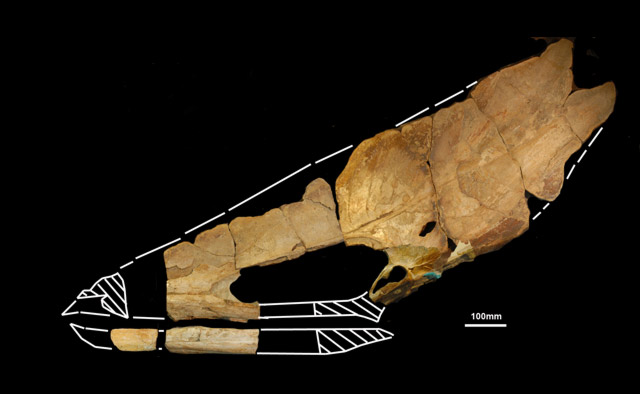[Recent Entries][Archive][Friends][User Info]
| November 11th, 2014 | ||||||||||||||||||||
|---|---|---|---|---|---|---|---|---|---|---|---|---|---|---|---|---|---|---|---|---|
| 04:13 pm [industrialterro] [Link] |
Thalassodromeus Талассодромеус (Thalassodromeus sethi, от др.-греч. θαλασσο- +δρομεύς «морской бегун», sethi — от имени Сета, из-за формы гребня) — птеродактиль из раннего мела Бразилии (формация Сантана, возраст около 122 − 109 млн.л.н.). Описан А. Келльнером и Д. Кампосом в 2002 году. Длина черепа до 1420 мм, череп высокий, имеется огромный затылочный гребень. Гребень очень тонкий, со следами кровеносных сосудов. Возможно, он служил для терморегуляции и для брачной демонстрации. На нижней челюсти в подбородочной области имеется небольшой вырост, который мог служить своеобразным килем-рассекателем, когда птерозавр опускал нижнюю челюсть в воду во время охоты. Способ питания талассодромеуса мог быть сходен со способом питания чаек-водорезов. Ящер летел низко над водой и опущенной нижней челюстью «резал» воду, выхватывая мелкую живность. В отличие от водорезов, талассодромеус мог достигать 4,5 метров в размахе крыльев. Это самое крупное известное животное, питавшееся по типу водореза. Тем не менее, недавние опыты на натурных моделях показали, что подобный способ питания для столь крупного животного был бы невозможен — челюсть создавала бы такое сопротивление, что ящер не мог бы удержать себя в воздухе. Родственные связи талассодромеуса не вполне ясны, он может быть родственником птеродактилей-тупуксар. В свою очередь, тупуксары близки к аждархидам. Thalassodromeus was a large pterodactyloid pterosaur found in northeastern Brazil. The genus was named in 2002 by Alexander Kellner and Diogenes de Almeida Campos. The type species is Thalassodromeus sethi. The genus name is derived from Greek thalasse, "sea" and dromaios, "runner", in reference to its presumed life style as a skimmer. The specific name refers to the Egyptian god Seth because of the similarity in head form. In 2006 André Jacques Veldmeijer suggested Kellner had confused Seth with the god Amun whose crown shows a remarkable resemblance with the Thalassodromeus head crest. The genus is based on holotype DGM 1476-R, a damaged partial skull, found in the Santana Formation. Thalassodromeus lived in the Early Cretaceous, roughly 108 million years ago. It shared the skies with its smaller cousin Tapejara. It is particularly notable for its immense head crest, beginning at the tip of the snout and ending far behind the braincase, which accounts for seventy-five percent of the surface of its 1.42 metre (4.6 ft) long skull. The jaws were pointed and toothless. It had a wing span of roughly 4.5 metres (14.7 ft). The function of the crest is unknown, but it may have been used for sexual display, species recognition, or thermoregulation. A lower jaw fragment referred to Thalassodromeus, DGM 1476-M, indicates a larger example with a wingspan of 5.3 metres (17.4 ft). Another jaw fragment, SAO 251093, was unofficially suggested to be a new species, "Thalassodromeus oberli" (referring to the Urs Oberli collection), by Veldmeijer in 2006, after having referred the specimen to T. sethi in 2005. In 2014 this was made a separate genus Banguela. Thalassodromeus was believed by Kellner to have fed in a similar way to modern skimmers; trailing its lower jaw in the water while it flew. However, later research on its jaw and neck anatomy suggested that for this and other larger pterosaurs it would not be feasible to skim because of the drag: the energy expenditure would be too high. Rather, Thalassodromeus appears to have had specialisation for terrestrial foraging like Azhdarchidae, even converging on leg proportions, and it's powerful jaws might suggest raptorial tendencies akin to those of phorusrhacids. Kellner assigned Thalassodromeus to the Tapejaridae. Other analyses however, showed that it was, joined with Tupuxuara in a Thalassodrominae, more closely related to the Azhdarchidae. Thalassodromidae (meaning "sea runners") is a family of pterodactyloid pterosaurs from the early Cretaceous period of Brazil. It contains two genera, Thalassodromeus and Tupuxuara. The classification of thalassodromids is controversial. Some studies, including one by Lü and colleagues in 2008, have found that the thalassodromids are more closely related to the azhdarchids than to the tapejarids, and have placed them in their own family (which has sometimes been referred to as Tupuxuaridae, though Thalassodrominae was named first). Alternately, they have been considered a subfamily (Thalassodrominae) within the Tapejaridae.
Репродукции (1, 2, 3, 4, 5, 6, 7, 8):
Размеры тела в сравнении с человеком: Tags: Вымершие рептилии, Мел, авеметатарзалии, аждархойды, архозавроморфы, архозавры, диапсиды, монофенестраты, орнитохейройды, птеродактили, птерозавры, талассодромиды, тапежариды | |||||||||||||||||||
| Comments | ||||||||||||||||||||
Слушай, правда, а нахрена им столько гребней? Почему у современных птиц такого нет, а у этих постоянно? Вроде бы экологическая ниша та же, летают, жрут всякую бегающую и плавающую мерзость, срут, ну и так далее.
У современных птиц тоже есть гребни же. Ну, у некоторых. А функция та же самая, что и у птиц - демонстрация перед самками (у самок гребни всегда меньше, чем у самцов). (Reply to this) (Parent) | ||||||||||||||||||||










